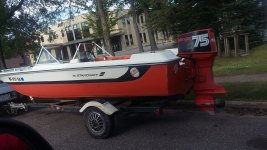moparschmidty
New member
1975 Johnson 3cyl loop charge 75hp 75ESLR75B
intermittent no/reduced power on accel.
Intermittently will not accelerate but to maybe 30% of potential, at other times runs fantastic, (although when running correctly, it would seem to me, it should respond faster to rapid launch/throttle up. if it were a street engine I'd bet it was Holley bog)
Meaning as simple as shut down and restart and it's fine. Throttle cable back and forth, shifting reverse and back to forward no change. I find no binding in mechanicals under flywheel (advance) .
Adding fuel (false fuel enrichment, during reduced power) made no difference.
I did some measurements with both my Fluke 87 & 88 for minmax AC voltages, as I do not have the DVA (direct voltage adapter) adapter, and my readings were not close to what's shown in CDI Troubleshoot values. (stator and timer base, white/black and black/white wires).
Would (should) the Fluke Minmax readings (low, high, and average) be the same as the recorded DVA readings?
Seeing that this is an intermittent, and I'm not big on diagnostic darts being thrown, and it resolves with a key cycle (most times), I'm leaning towards the power pack (screw type) not switching over in timing advance. (lack of correct tool and knowledge/experience, may lead to SWAG diagnostics, Scientific Wild Ass Guess)
After a key cycle (or two) it runs okay. Is there such electronic ignition control in stator or timer base, to control timing advance, that could be affected by cycling the key? (switched ignition)
Work performed so far (and it's winter and working from memory of last season)
1 - I installed a bypass toggle switch in black with yellow (stop) wire, that made no difference.
Idles fine when this happens.
2 - Rectifier replaced, wire insulation (s) were burnt and it looked like it may have been grounding out.
3 - Carbs cleaned out
4 - Rubber hoses replaced
5 - Powers and grounds are good
intermittent no/reduced power on accel.
Intermittently will not accelerate but to maybe 30% of potential, at other times runs fantastic, (although when running correctly, it would seem to me, it should respond faster to rapid launch/throttle up. if it were a street engine I'd bet it was Holley bog)
Meaning as simple as shut down and restart and it's fine. Throttle cable back and forth, shifting reverse and back to forward no change. I find no binding in mechanicals under flywheel (advance) .
Adding fuel (false fuel enrichment, during reduced power) made no difference.
I did some measurements with both my Fluke 87 & 88 for minmax AC voltages, as I do not have the DVA (direct voltage adapter) adapter, and my readings were not close to what's shown in CDI Troubleshoot values. (stator and timer base, white/black and black/white wires).
Would (should) the Fluke Minmax readings (low, high, and average) be the same as the recorded DVA readings?
Seeing that this is an intermittent, and I'm not big on diagnostic darts being thrown, and it resolves with a key cycle (most times), I'm leaning towards the power pack (screw type) not switching over in timing advance. (lack of correct tool and knowledge/experience, may lead to SWAG diagnostics, Scientific Wild Ass Guess)
After a key cycle (or two) it runs okay. Is there such electronic ignition control in stator or timer base, to control timing advance, that could be affected by cycling the key? (switched ignition)
Work performed so far (and it's winter and working from memory of last season)
1 - I installed a bypass toggle switch in black with yellow (stop) wire, that made no difference.
Idles fine when this happens.
2 - Rectifier replaced, wire insulation (s) were burnt and it looked like it may have been grounding out.
3 - Carbs cleaned out
4 - Rubber hoses replaced
5 - Powers and grounds are good


